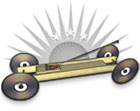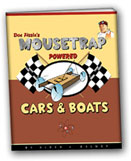Mousetrap Vehicles: Energy
Energy is what does work. Energy cannot be created nor can it be destroyed but it can be changed. Learn all about energy and how it applies to mousetrap vehicles.
Perhaps the single most important concept to understand in order to build a mousetrap powered vehicle is the concept of energy. Energy is defined as having the ability to do work and work is the displacement of an object that result in something being done. Without energy the universe would be motionless and without life. We usually observe energy only when it is happening or when it is being trans-formed from one form to another. Energy can be classified in a number of ways but most commonly energy is classified as potential and kinetic. The energy that is stored and/or held in readiness is called potential energy (PE). For example, a stretched or compressed spring has the potential to do work. When a bow is drawn energy is stored in the bow and when the bow is released the potential energy is used to launch the arrow. Kinetic energy (KE) is energy of motion or the energy a moving object has. From our example, the arrow now has kinetic energy because of it's motion just as a baseball thrown through the air also has kinetic energy because of it's motion. The work that was done on the arrow was to changed it's state of motion. The bow applied a force to the arrow through some distance, the amount of force through the distance represents the work done to the arrow.
W = F × d
formula: work [w] is defined in the mathematical terms as a force [f] applied through a distance [d]. This equation is only good for a constant force. Work is measured in joules, force in newtons, and distance in meters.
Energy always follows one basic law called the Law of Conservation of Energy that states: Energy cannot be created or destroyed but it can be changed from one form to another but the total amount of energy in a system will remain constant. Loading the spring of a mouse trap stores potential energy and when that spring is released the potential energy is turns into kinetic energy or the energy of motion but the total amount of energy that the system starts with will always be the same as the energy the system ends with. In a perfect universe a mousetrap vehicle would roll forever once the potential energy is changed into kinetic energy. But in our universe there is friction and in order to overcome friction your mousetrap car will have to do work. Friction converts the energy of a moving objects into heat and sound and this will eventually causes a moving object to come to a stop. Energy is not destroyed by this process but it is being converted into heat and sound. The total energy of a system at any moment in time is always the sum of the potential energy, the kinetic energy, and the total of the heat and sound energy.

bonus tip: Heat and sound are forms of energy caused by friction.
ETotal = PE + KE + W
formula: the total energy of any system is the sum of the potential energy, the kinetic energy, work lost to heat and sound, and any work done to overcome friction. All energy is measured in joules.
Potential Energy
Potential energy [PE] is the energy energy an object has because of it's position. Most of the time we talk about an objects potential energy in reference to the objects position above the earth such as a rock held in an out stretched hand and ready to be release. This rock has the potential to do work, when release it will convert it's potential energy into kinetic energy (the energy of motion) and it will do work as it plows it way through the air and displaces its position.

potential energy: an object has potential energy because of it's position.
PE = mgh
formula: the potential energy [PE] of an object because of its position above the earth is equal to the acceleration of gravity [g], times the mass [m] of the object, times the height [h] above the ground. Potential energy is measured in joules, mass in kilograms, acceleration in m per second squared, and height in meters.
Energy of Springs and Rubber Bands
A stretched and/or compress spring/rubber band has potential energy because of the it's position. When you stretch a spring or rubber band you can feel the energy being stored as the force of the spring or rubber band pulled back; it is easy to see that the stretched spring or rubber band has energy in waiting. These springs follow Hooke's law that states that the force of the spring/rubber band is equal to the spring's/rubber band's strength time how far it is stretched.
F = -kx
formula: the force [f] of a stretched/compressed spring is equal to the spring constant [k] times the distance [x] the spring is stretched/compressed. Force is measured in newtons, the spring constant in newtons per meters, and distance in meters.
PE = (1/2) × kx2
potential energy: the potential energy [pe] of a stretched/compressed spring is equal to one-half the spring constant [k] times the distance [x] stretched/compressed squared. Potential energy is measured in joules, the spring constant in newtons per meter, and the distance in meters.
Torsional Springs
A mouse trap is a spring but instead of being stretched/compressed in the linear direction the mouse trap's spring is wound in a helical direction. This special spring still follows Hooke's law but we have to replace the linear quantities with rotational quantities. Instead of measuring how far the spring is stretched/compressed we measure how much the spring is wound-up or the angle in radians of twist.
τ = -kθ
formula: the torque of a torsional spring is equal to the spring constant [k] times the angle of twist [θ]. Torque is measured in newtons times meters, the spring constant is measured in newtons per meter, and the angle of the twist is measured in radians.
PE = (1/2) × kθ2
potential energy: the potential energy [pe] of a torsional spring is equal to one-half the spring constant [k] times the angle of the twist [θ]. the potential energy is measured in joules, the spring constant is measured in newtons per meter, and the angle of the twist is measured in radians.

torsional spring: a mousetrap is an example of a torsional spring.
Kinetic Energy
Kinetic energy [KE] is the energy an object has because of it's motion. A bowling ball traveling down an ally has energy because of it's motion and this energy can do work such as knock over some pins. The kinetic depends on the bowling balls depends on the mass of the ball and how fast it is moving. With kinetic energy, an objects speed is much more important that it's mass, doubling an objects speed and it has four times the energy.
KE = (1/2) × mv2
kinetic energy: the kinetic energy [ke] of a moving object is equal to one-half the mass [m] of the object times the velocity [v] of the object squared. Kinetic energy is measured in joules, the mass in kilograms, and velocity in meters per second.
Kinetic Energy of Rotation
The true kinetic energy of the bowling ball depends not only on it's linear motion down the ally but also the balls rotational kinetic energy as it rolls. All rotating objects have kinetic energy that depends on and objects rotational inertia and the rate at which the object is rotating.
KErotational = (1/2) × Iω2
rotational energy: the kinetic energy [ke] of a rotating object is equal to one-half the objects rotational inertia [I] times the angular velocity [ω] of the object squared. Kinetic energy is measured in joules, the rotational inertia is measured in kilograms times meters squared, and angular velocity in radians per second.
Total Kinetic Energy
The total kinetic energy of any object is the sum of the linear kinetic energy plus the sum of all the rotational kinetic energy. For a moving vehicle the total kinetic energy is the sum of the vehicle's linear kinetic energy plus the sum of all the rotational energy in each wheel.
KETotal = KELinear + KERotational
kinetic energy: the kinetic energy total [ke] of an object is equal to the objects linear kinetic energy plus the sum of all the rotational kinetic energy. All energy is measured in joules.
Work
Work is what energy does, most of the time this means displacing an object from one location to a new one. When you lift a rock you use energy to move the rock from its old position to a new position. On earth we also have to deal with friction. If we look at the total energy involved in moving the rock from our example we will find that more energy was put into the system then what was required to displacing the rock only. This is because some energy was needed to overcome friction. Friction is a force that acts against the motion of all moving objects, friction takes energy away from a system and turns it into heat and sound. The total amount of work done is always the sum of the actual work plus the work lost to friction
WTotal = Wdone + Wfriction
total energy: the total work [W] is equal to work done plus the energy lost to friction All energy is measured in joules.
*Can't find what you're looking for? Ask Doc Fizzix »




